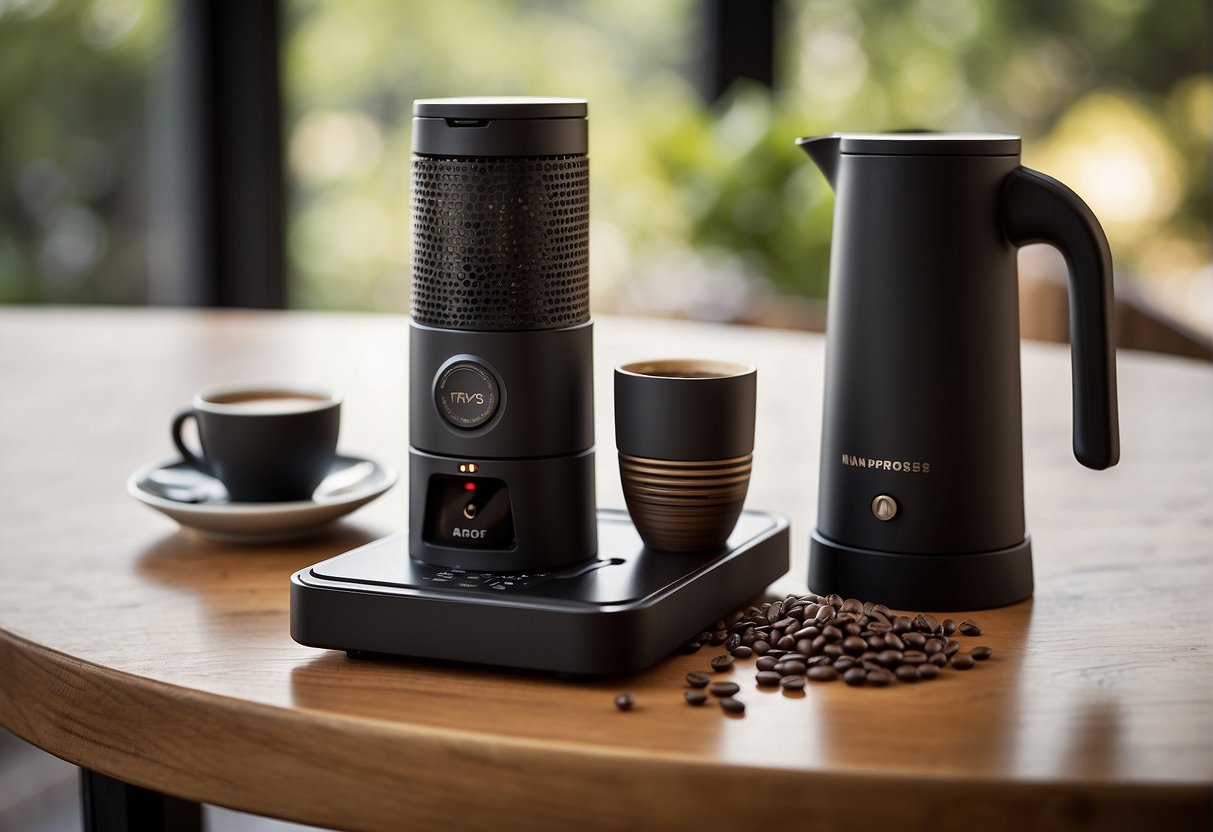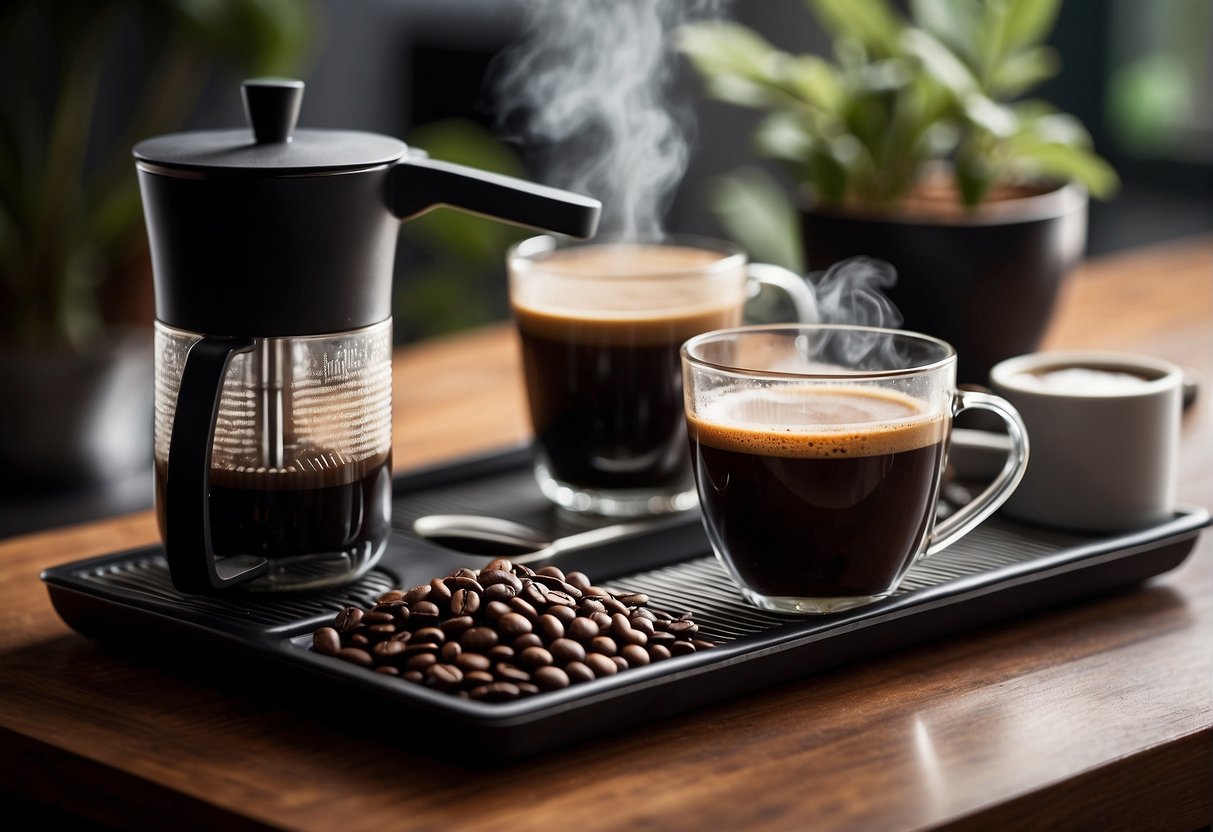The quest for the perfect cup of coffee often leads enthusiasts to explore various brewing methods. Two popular contenders in the realm of portable coffee makers are the Nanopresso and the AeroPress. Both devices have garnered attention for their ability to produce high-quality coffee in a compact form, but they approach the task with distinct methodologies that cater to different preferences and coffee brewing traditions.

The Nanopresso prides itself on being a portable espresso maker, capable of creating a rich shot complete with crema, akin to traditional espresso machines. Its design emphasizes pressure, using a manual pump to reach up to 18 bars, allowing for the extraction of flavors usually expected from a device many times its size. Comparatively, the AeroPress is a versatile coffee maker that uses a rapid, total immersion brewing process along with gentle pressure to make both American-style coffee and a coffee closely resembling espresso.
When considering the Nanopresso and AeroPress, one must ponder not only the type of coffee preferred but also factors such as ease of use, portability, and the consistency of the resulting brew. Each has its own set of pros and cons, as the AeroPress tends to be more forgiving and adaptable, while the Nanopresso requires a more precise technique to harness its full potential. The debate between the two is not just about taste but also about the ritual and experience of brewing a cherished cup of coffee away from the comforts of a fully-equipped kitchen.
Overview of Nanopresso and Aeropress
https://www.youtube.com/watch?v=GNNoOtvK6oc&embed=true
When searching for a portable coffee maker, two standout options that aficionados often compare are the Nanopresso and Aeropress. These devices have distinct features that cater to different preferences for brewing on the go.
What is a Nanopresso?
The Nanopresso, developed by Wacaco, is a compact and lightweight espresso maker, known for its ability to achieve high pressure to create rich espresso with crema. It operates manually, requiring no electricity or batteries. The standard pressure generated can reach up to 18 bars, surpassing the espresso machine standard of 9 bars. Its portability is a significant advantage for those who wish to enjoy espresso outdoors or during travel.
What is an Aeropress?
On the other hand, the Aeropress is a versatile and durable coffee maker that uses air pressure to brew a variety of coffee styles, from Americanos to espresso-like concentrates, though not true espresso. The Aeropress has a rapid brewing process, emphasizing total immersion and quick filtration that provides a rich but smooth coffee flavor. Aeropress also offers the Aeropress Go version, a slightly smaller and more travel-friendly version, maintaining the same brewing quality but with added convenience for those on the move.
Key Features and Design

When choosing between the Nanopresso and Aeropress, consumers typically consider the device’s size, brewing capabilities, and the quality of its construction. Each of these portable coffee makers has distinct features that cater to different preferences and lifestyles.
Size and Portability
The Nanopresso boasts a highly compact design, with dimensions that facilitate ease of travel. Due to its lightweight nature, it is a favorite for those who wish to enjoy espresso while on the move. In contrast, the Aeropress and Aeropress Go offer a slightly bulkier option, yet still maintain a travel-friendly profile. Both coffee makers are designed to be portable; however, the Nanopresso provides a smaller footprint.
Brewing Capacity
As a portable espresso maker, the Nanopresso operates with a brewing capacity conducive to producing single shots of espresso. Its design is such that quality is prioritized over quantity. Conversely, the Aeropress offers more versatility with the ability to brew both coffee and espresso-style drinks. Both models advocate simplicity in their brewing process, accommodating a quick and efficient method to suit those with a busy lifestyle.
Design and Build Quality
Durability is evident in the build quality of both the Nanopresso and Aeropress. The Nanopresso’s construction integrates 18 bar pressure, rivaling that of full-sized espresso machines, as indicated by a review from Home Coffee Expert. The Aeropress features a more utilitarian design, focusing on durability and simplicity, making it well-suited for both kitchen countertops and outdoor use. Its robust design is meant to withstand the rigors of frequent travel.
Brewing Experience

When comparing the NanoPresso and AeroPress, key factors shaping the brewing experience include the flavors each method can extract, their general ease of use, and their versatility when adapting to different coffee styles and situations.
Flavors and Extraction
The NanoPresso prides itself on its ability to generate up to 18 bars of pressure, making it the go-to choice for a rich espresso with a notable crema. This high pressure facilitates a full extraction, resulting in bold flavors and pronounced bitterness which is characteristic of espresso. Alternatively, the AeroPress opts for a rapid, total-immersion brewing process, where a more balanced flavor profile is achieved, capturing both sweetness and acidity without emphasizing the bitterness.
Ease of Use
In terms of operating each device, the AeroPress is simpler to use, requiring only the addition of coffee and hot water before pressing through a filter with its plunger. It’s forgiving and adaptable to varied grind sizes. On the other hand, the NanoPresso demands a finer grind and a bit more finesse to handle the pressure effectively, potentially posing a challenge for consistent results.
Versatility and Adaptability
The AeroPress is a more versatile tool, capable of making regular coffee and pseudo-espresso when needed, especially convenient for travel due to its durability and ease of cleaning. It also allows the use of either paper or metal filters to tweak the body and taste of the coffee. Meanwhile, the NanoPresso is designed specifically for espresso lovers on the go, but its maintenance and cleaning can be more demanding in comparison, due to its compact and intricate parts.
Comparison by Use Case
In selecting between the Nanopresso and Aeropress, one must consider how each device meets the specific needs of travel, cleaning convenience, and the variety of coffee they wish to enjoy.
Travel and Mobility
Nanopresso: Ideal for those who are frequently on the move and have minimal luggage space, such as backpacking or camping trips. Its compact design and the availability of a protective case enhance its portability. The grinder and capsule adapter add-ons increase its versatility for travelers who prefer freshly ground beans or the convenience of coffee capsules.
Aeropress: Also travel-friendly, especially with the AeroPress Go version designed for optimal mobility. Although slightly less compact than the Nanopresso, it remains a top choice for individuals who prioritize simplicity and speed in preparing their coffee during travel or office use.
Ease of Cleaning
Nanopresso: Requires more meticulous cleaning due to its complex parts, which might not be dishwasher safe. For those out in nature or away from kitchen conveniences, this could be a slight inconvenience.
Aeropress: Known for its straightforward cleaning process, it is advantageous for users on the go. Many of its components are dishwasher safe, making it a practical option for both outdoor adventures and daily office use.
Coffee Variety
Nanopresso: Celebrated for its capability to produce authentic espresso with crema, appealing to those with a preference for strong, espresso-based drinks. However, it does not cater to cold brew enthusiasts.
Aeropress: Offers a wider range of possibilities, from classic black coffee to pseudo-espresso and even cold brew, satisfying a broader spectrum of preferences. While it may not yield an espresso with the same intensity as the Nanopresso, its versatility is a significant advantage for users who enjoy experimenting with different brewing techniques and coffee styles.
Additional accessories like the Cafflano Kompresso can further enhance the Aeropress capabilities, catering to the tastes of a more diverse coffee audience.
Pricing and Value for Money
When comparing the Nanopresso and Aeropress, one must consider not only the initial cost but also the long-term value each coffee maker offers. Both are invested by those who appreciate quality coffee on the go, but each comes with different pricing and potential value for the money spent.
Cost Analysis
The Nanopresso, developed by Wacaco, is typically more expensive, with prices varying depending on the model and accessories chosen. It is regarded by some as a premium option for portable coffee makers. On the other hand, the Aeropress is often seen as an affordable alternative with a lower price point, making it accessible for casual coffee enthusiasts and seasoned baristas alike.
- Nanopresso: Average Price ~ $70 – $90
- Aeropress: Average Price ~ $30 – $35
Longevity and Return on Investment
In terms of longevity, both devices are known for their durability. The investment in a Nanopresso might be justified by its ability to create close to authentic espresso, which might appeal to users with a more refined palate or those following tech trends in coffee gear. The Aeropress, while not yielding true espresso, is commended for its versatility and consistently high-performance brews. Users must assess whether the additional cost of the Nanopresso correlates with their expectations of coffee quality and the importance of espresso in their daily routine.
- Nanopresso: Well-built with a focus on espresso, appeals to tech enthusiasts
- Aeropress: Durable, versatile, and offers great value for performance
User Reviews and Community
When considering the purchase of a portable coffee maker, prospective buyers often weigh user testimonials and expert analysis. The Nanopresso and Aeropress coffee makers have both carved their niches within the coffee enthusiast community, with varying feedback highlighting their utility, design, and quality of brew.
Customer Feedback
-
Nanopresso: Users often praise the Nanopresso for its ability to produce robust espresso with a satisfactory crema. It is highlighted for being a real espresso maker among portable options. However, some note it requires a learning curve to achieve consistent results. A Reddit discussion features coffee aficionados sharing their experiences, with one user vividly comparing the Nanopresso espresso to “a 3:00am karaoke bar rendition of espresso,” suggesting that while good, it may not fully equate to a traditional espresso experience.
-
Aeropress: Conversely, the Aeropress is commonly commended for its ease of use and control over the brewing process, yielding a strong and sweet black coffee. It’s appreciated for its versatility, noted for rapid total immersion brewing, and ability to create a coffee closely resembling espresso but, as pointed out on Rayend’s website, it does not achieve the high pressure truly required for authentic espresso.
Expert Opinions
-
Espresso Quality: Specialists affirm the Nanopresso’s credibility as an espresso maker, particularly because it can reach the pressure levels needed for a traditional espresso shot. Experts from BaristaJoy emphasize its single-serve capability and real espresso making contrasted with the Aeropress’s immersion method.
-
Portability and Ease of Use: Furthermore, comparisons often note the Aeropress’s unrivaled simplicity and the recent launch of the AeroPress Go, which adds to its portability. While the Nanopresso might cater to espresso purists on the move, the Aeropress expands its appeal through its straightforward design, often making it a recommended choice by experts for those prioritizing convenience.
Both devices have a strong following, with video reviews and community discussions commonly available, allowing potential users to gauge which coffee maker might best suit their preferences and lifestyle. The Picopresso and Minipresso, also part of the Wacaco line, find mentions for their own strengths, contributing further options to the portable coffee maker market.
